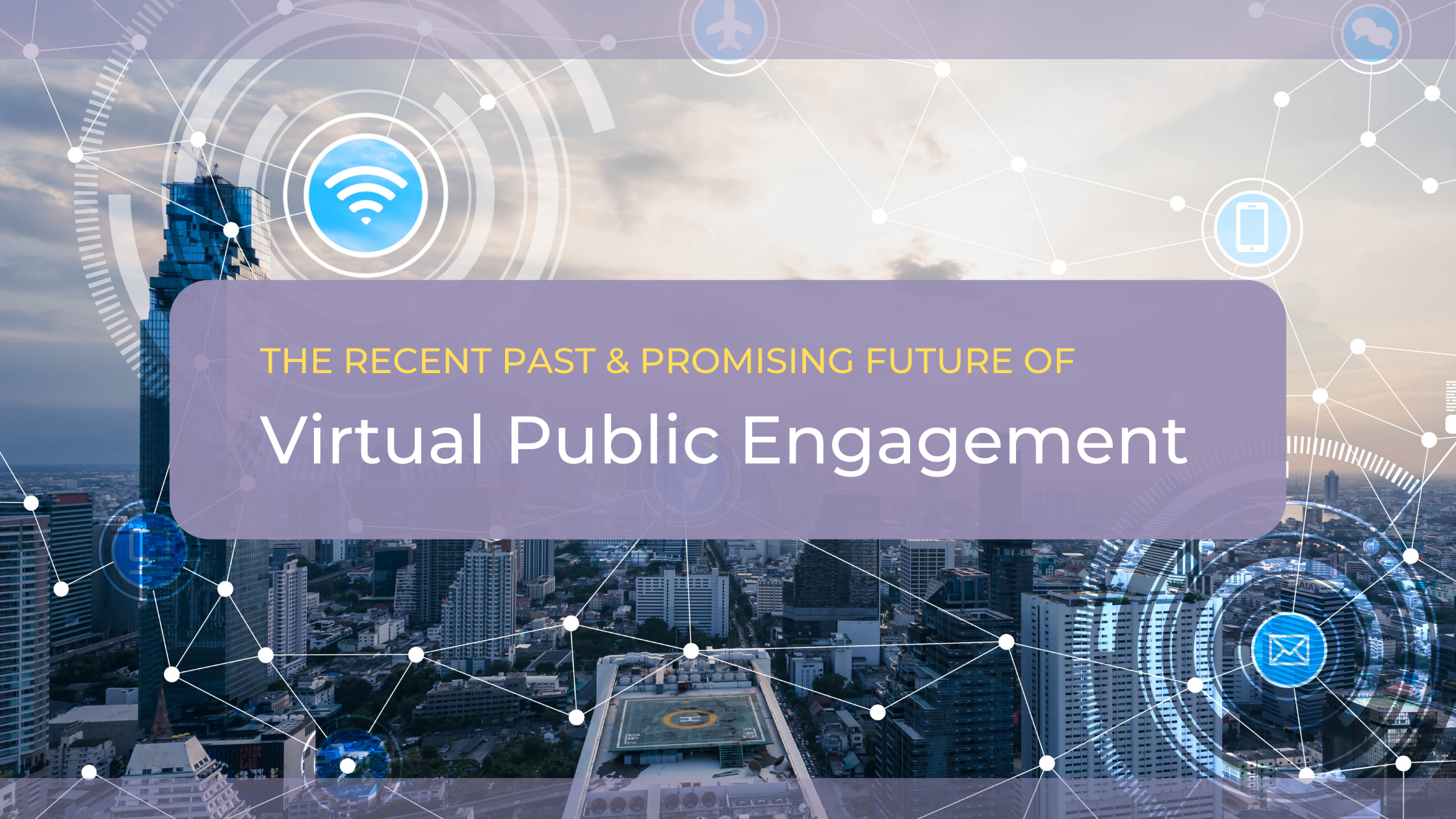
PublicInput had the pleasure to join other public engagement tech companies on a virtual panel at the 2021 IAP2 North America Conference. Sharing our experiences, insights and predictions surrounding virtual public engagement with our colleagues and practitioners is always an enjoyable and productive experience.
Dr. Kristin Williams with PublicInput, joined Aaron Bernard of Spatial Media, Ward Ferguson of Jambo and Joseph Thornley, of 76Engage. Aaron’s Spatial Media colleague, Rohan Aurora, moderated the panel that addressed three questions concerning the impact of the pandemic on public engagement, adapting new technologies to existing engagement practices, and future predictions.
Below is a summary of the exchange that ensued.

Question #1 – The Pandemic:
What was the impact and trends that emerged to engagement?
This was a retrospective question to explore lessons learned. A general observation from the panelists addressed how unprepared technologically and procedurally many public institutions were to respond when conventional, in-person engagement and deliberations were halted. However, everyone acknowledged and credited local governing bodies for their quick actions and creativity, along with a seasoned group of public engagement practitioners to respond and adapt to the dire circumstances and the need for continuity of our public institutions.
Panelists noted the presence of new government staff who not only attended the virtual public meetings (VPMs) but were also running them on behalf of their organizations: the CIO or IT department. Their chief role was to ensure virtual meetings would be convened with as little disruption as possible.
The panelists cited their own experience working with customers and feedback from public engagement practitioners about the challenges to integrate technology platforms in their proceedings, however, there is general acceptance of their benefits and for using virtual public meetings in the future and interest in blending them with in-person deliberations currently and to continue after the pandemic subsides. These views were also noted in a study by Engaging Local Government Leaders (ELGL) and others that found support to continue the use of virtual meetings and mirrors the thoughts of PublicInput.
Data collected over the past 18 months demonstrate VPMs are having a positive impact on public engagement. And with the resurgence of the COVID Delta variant governments are not in a hurry to cast aside their role in governing and democracy. VPMs provide a sustainable option for increasing public participation and offer jurisdictions with an effective input and feedback tool to increase diversity, equity and inclusion in their deliberations.
Providing a “win-win-win-win” scenario benefiting public engagement practitioners, governing bodies, govtech solution providers and residents, the panelists were optimistic about wider adoption and a bright future for VPMs.

Question #2 – Adaptation:
What are people doing today that could be improved with tech?
The moderator asked panelists to share advice with the attendees from what they have learned and are seeing in virtual public engagement practices. Panelists suggested that 2020 was a tumultuous year for public participation due to the pandemic, the social injustice protests surrounding police reforms and a divisive, polarized presidential election followed.
“We are at a pivotal point in the relationship between the government and constituents,” noted Dr. Williams. There was mutual agreement that trust in government and trust in society had suffered and one way to help rebuild trust was through greater transparency, inclusive participation and accountability. And solutions to address those challenges will have to come through greater use of technology to encourage and facilitate greater collaboration between government and residents.
Panelists also discussed the benefits and potential liabilities for governments using social networks as public engagement platforms versus the government’s own and managed engagement platform. There was some disagreement on this topic between PublicInput’s Williams and Jambo’s Thornley. Thornley argued against their use as it provides the private social networks with free data from the public. Williams suggested there were some roles for the social networks in public engagement as communication and information providers. Both panelists agreed to continue the conversation beyond the IAP2 session as this is an important, unresolved topic surrounding data ownership, security and privacy.
Question #3 – The Future:
What does the future look like for engagement and technology?
The moderator suggested the panelists address this hypothetical question by identifying social and technological trends that have and could impact the future of public engagement. As an example, the moderator asked how tech support might foster or potentially present challenges to engagement practices.
There was total agreement among the panelists that a new era of public engagement and representative democracy is emerging thanks in part to a changing culture and enabling technologies. This includes new models for how governance and public engagement are administered and how to use media tools to rebuild public governance.
The panelists returned to the experiences of local governments during the pandemic and the use of VPMs and its potential to be at the center for public participation. This discussion included trending topics in public engagement around growing interests in blended, or hybrid models of public engagement that combines conventional, in-person methods with virtual models.
Panelists suggested as the new technologies become more ubiquitous and more user friendly, the heavy emphasis on CIOs and IT will fade with administration of these platforms directed by staff who traditionally played a role in public engagement.
Finally, panelists cited the opportunity to increase and expand the use of virtual public engagement to opportunities beyond council meetings and public project feedback to tap into the knowledge of their residents for contributions to solutions for the many socio-economic challenges local governments and communities are facing.
See how PublicInput is helping agencies, like yours, with virtual public engagement.




